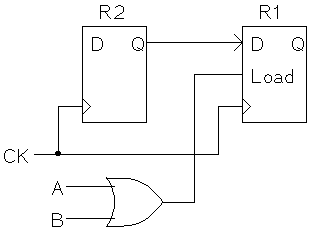What is Register Transfer Language (RTL)?
Table of Contents

- jaro education
- 12, July 2024
- 11:00 am
Register Transfer Language (RTL) is fundamental to computer architecture and is used heavily when designing and building digital systems. It is used to define the functionality of a computer and how it processes stores, and transmits its data. This language helps in specifying the behavior of electronic systems in a clear and standardized manner, making it easier for designers to develop complex circuits and systems. Whether you are designing a simple microcontroller or a sophisticated processor, understanding RTL is essential.
It is important for anyone who is contemplating a career in computer engineering or is embarking on a career in digital design. In this blog post, we will discuss Register Transfer Language, the importance of RTL, and its features in the wide spectrum of digital design.
Let’s delve into the basic components of Register Transfer Language and understand with some examples.
Basics of Register Transfer Language
Let’s delve into the basic components of Register Transfer Language and understand with some examples.
Components of RTL
Before we proceed with other elements, let’s define the components of Register Transfer Language for clear understanding.
-
- Registers: These are storage elements that store data. Think of them as small and swift storage spaces located within the CPU.
- Operations: The operations are carried out on data stored in registers. It includes activities like addition, subtraction, and logic.
- Control Signals: These signals control and manage the system’s functions and data handling.
These components assist in comprehending the flow of data and how it is manipulated within the computer.
Examples of Simple Register Transfers
Here are some basic examples of register transfer language for better understanding.
- Load Operations: This is a process of transferring data from memory to a register.
- Example: M[100] -> R1 (Transfer the value stored at memory location 100 into register R1).
- Move Operations: This entails moving data from one register to the other.
- Example: T3 <- T2 (Copy the content of register T2 into T1).
These examples show the basic movements and operations within a CPU using Register Transfer Language.
Understanding RTL Notation
It is important to comprehend the symbols used in Register Transfer Language when designing and communicating digital circuits.

Common Symbols and Notation Used in RTL
In RTL, different symbols are assigned to various operations and components. Therefore, it is important to gain knowledge and comprehend these symbols to comprehend and write in RTL.
-
- R1, R2, R3… represent registers.
- M[ ] represents memory locations.
- <- denotes data transfer.
Importance of Standard Notation in Design and Communication
Standard notation helps in proper communication between the designers and the engineers. It makes it easier to capture and communicate designs, knowledge that enables teams to review each other’s work and understand the details. This standardization is crucial for Register Transfer Language in Computer Architecture.
The Role of RTL in Digital Design
RTL in the Design and Simulation of Digital Circuits
Conversion of RTL to Hardware Description Language (HDL)
After the RTL design is complete and verified, it is translated into Hardware Description Language (HDL), Verilog, or VHDL. This step is important since the HDLs are used to implement the actual hardware.
Example: RTL to Verilog/VHDL
For instance, an RTL description like R1 <- R2 + R3 in Verilog would look like:
verilog Copy code always @(posedge clk) begin R1 <= R2 + R3; endThis translation demonstrates how the concepts of RTL are mapped and used in hardware description languages.
RTL Design Process
The design process of Register Transfer Language involves many stages, all important for developing precise and effective digital systems. This section gives a deeper view of every step involved in the RTL design process.
1. High-Level Design
High-level design is the initial part of the RTL design process. In this stage, designers make a conceptual structure for the system. They sketch out the main elements and how they interact with each other. The main focus is on the architecture as a whole. The most important activities include:
- Defining the system’s functionality and behavior.
- Identifying the main modules and their relationships.
- Block diagrams are created to represent the system architecture.
High-level design provides a blueprint that guides the detailed design and coding stages.
2. RTL Coding
After the high-level design is set, we move to RTL coding. This step means converting the conceptual design into accurate RTL code. RTL coding needs a deep comprehension of register transfer language along with its notation. The activities in this stage include:
-
- Describing data transfers between registers.
- Specifying the operations performed on the data.
- Defining control signals to manage data flow and operations.
After the system’s high-level design phase, RTL coding translates it into a thorough and executable structure explanation.
3. RTL Verification
After the high-level design is set, we move to RTL coding. This step means converting the conceptual design into accurate RTL code. RTL coding needs a deep comprehension of register transfer language along with its notation. The activities in this stage include:
- Describing data transfers between registers.
- Specifying the operations performed on the data.
- Defining control signals to manage data flow and operations.
After the system’s high-level design phase, RTL coding translates it into a thorough and executable structure explanation.
4. Synthesis and Optimization
The last stage in the RTL design steps is synthesis and optimization. It turns confirmed RTL code into a gate-level design that can be used in hardware. The task of synthesis is to change the high-level description given by RTL into logic gates and their connections. Key activities include:
- Using synthesis tools to generate the gate-level design.
- Applying optimization techniques to improve performance and efficiency.
- Validating the synthesized design to ensure it matches the original RTL specifications.
Optimization focuses on improving the speed, area, and power make it more efficient and feasible for hardware creationconsumption of the design to
Advantages of Using RTL
Digital design with Register Transfer Language provides multiple advantages, improving the general process and result of design.
Improved Accuracy in Design
The Register Transfer Language gives a clear method for expressing digital systems, which leads to precise and reliable designs.
Enhanced Design Verification
Using RTL simulation, engineers can identify and rectify errors in the initial stages of design, thereby minimizing costly mistakes.
Facilitation of Automated Testing and Synthesis
Register Transfer Language helps automated tools test and create designs, making the process of creating designs more organized and effective.
Challenges and Consideration
Common Pitfalls in RTL Design
Strategies for Effective RTL Coding and Verification
Future Trends in RTL
Common Pitfalls in RTL Design
The field of Register Transfer Language is constantly changing based on new technologies and methodologies. Let’s have a look at which factors have shaped the RTL trends.
Evolving Standards and Methodologies
Integration with Emerging Technologies
Effect on Future Hardware Design
Such developments ensure that RTL will always be a fundamental concept in advanced hardware design regardless of evolving requirements.
Conclusion
Register Transfer Language is one of the basic concepts of digital design that continues to be relevant in contemporary computer architecture. As a result, understanding and applying Register Transfer Language in computer architecture can help designers design accurate, efficient and reliable digital systems. The RTL is going to be an important part of future hardware design as technology advances.
To further improve your knowledge and design skills, consider enrolling in the Certificate Program in Digital VLSI Design offered by CEP, IIT Delhi. This 3-month online course offers a well-rounded curriculum covering register transfer language and other essential aspects of digital design. Taught by experienced faculty, the program includes hands-on projects and interactive lectures, providing a practical learning experience.
Whether you’re looking to advance your career or deepen your understanding, this course will equip you with the skills needed for success in the field.













1 thought on “What is Register Transfer Language (RTL)?”
This blog provides a comprehensive overview of the career opportunities available after completing Verilog online courses. The insights on how Verilog expertise can enhance job prospects and career growth are particularly valuable. Thank you for such a detailed and informative post.